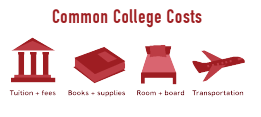Opportunities for college fee waivers slim

BLOT GRAPHICS BY SABRINA Z. LIDING and ZAINA SAIF
The costly fees for the admissions process of college start to arise attention.
May 20, 2022
The college admissions process is a long and expensive ordeal. Two SATs cost $110 and applications to six colleges cost $300 on average, according to college financial service Edmit. By the United States Department of Agriculture’s (USDA) standards, this is more than enough money to feed a family of four for a week.
Some of these fees can be avoided if students can prove that they face financial difficulties. According to College Board and ACT.org, if they’re enrolled in a free lunch or financial aid program, identify as an orphan or ward of the state or if their family’s household income falls within the USDA’s Income Eligibility Guidelines, they can receive a standardized test waiver.
While a waiver is mainly used to nullify a test fee, it also offers free learning courses and practice tests. That being said, these benefits are limited. As stated on each tests’ official site, students can only receive four free ACTs or two free SATs with a waiver. Despite this drawback, CHS guidance counselor Sandra Gidos believes the limitations are in students’ best interest.
“The more times you take it, it doesn’t necessarily mean the better you’re going to get,” Gidos said. “It’s best to use your time wisely and to study and prepare for it, so I think it’s an advantage.”
After completing standardized testing, the college application process begins. This is an undertaking in which students may spend money on almost every school application. Senior Kacie Farrell of Lincroft believes that these expenses are unjustifiable, especially for students who may not even be admitted to the schools they apply to.
“I think it’s way too expensive,” Farrell said. “I don’t understand why you have to apply just to be rejected from some places, like you have to pay a deposit and pay for the application.”
Others see benefits in these fees, as looking through student resumes requires employee labor. Harvard, which charges $75 for its application, explains where these funds go on its applications page.
“This is needed to open your admissions file, track your documents, and set up an interview,” the page states.
Gidos agrees that the fees exist for a reason, but also sees how they can be a problem.
“I think there should be a fee but maybe not as expensive,” Gidos said. “If [these fees weren’t in place], I think there would be no limit to the number of schools that a student would apply to, and right now there’s a record-breaking number of applications, which has made the admissions rate even smaller.”
With these fees also come fee waivers. Some schools will accept waivers from the SAT or ACT, such as Dartmouth College or Georgetown, while others like Yale require students to complete a new waiver separate from their standardized tests.
Even if a student doesn’t fit into an economic situation that would constitute the use of a fee waiver, there are still opportunities for them to avoid some of the fees of the college application process. If a student tours a school, they could obtain a waiver without needing to apply.
“A lot of [my friends] have actually applied to colleges just because they got a fee waiver since it was easy and accessible,” Farrell said. “It’s definitely a big draw for people who are applying to college.”
Junior Alex Dornemann of Eatontown understands how giving waivers to touring students can be a beneficial, but also sees the problems with this approach.
“I think [college tours] favor people who live close by,” Dornemann said. “It’s a good way to bypass the fee. It definitely isn’t fair for people who can’t travel.”
Gidos also explains that colleges will try to accommodate students who reach out or make an effort to learn about the school, regardless of their financial situation.
“[The eligibility requirements] are narrow because it’s just like financial aid, it’s really hard to get, especially for the middle class,” Gidos said. “But if there’s a problem I think colleges are very likely to work with you, even if you visit a school a lot of times they’ll give you a waiver for application fees. It’s a nice advantage.”




